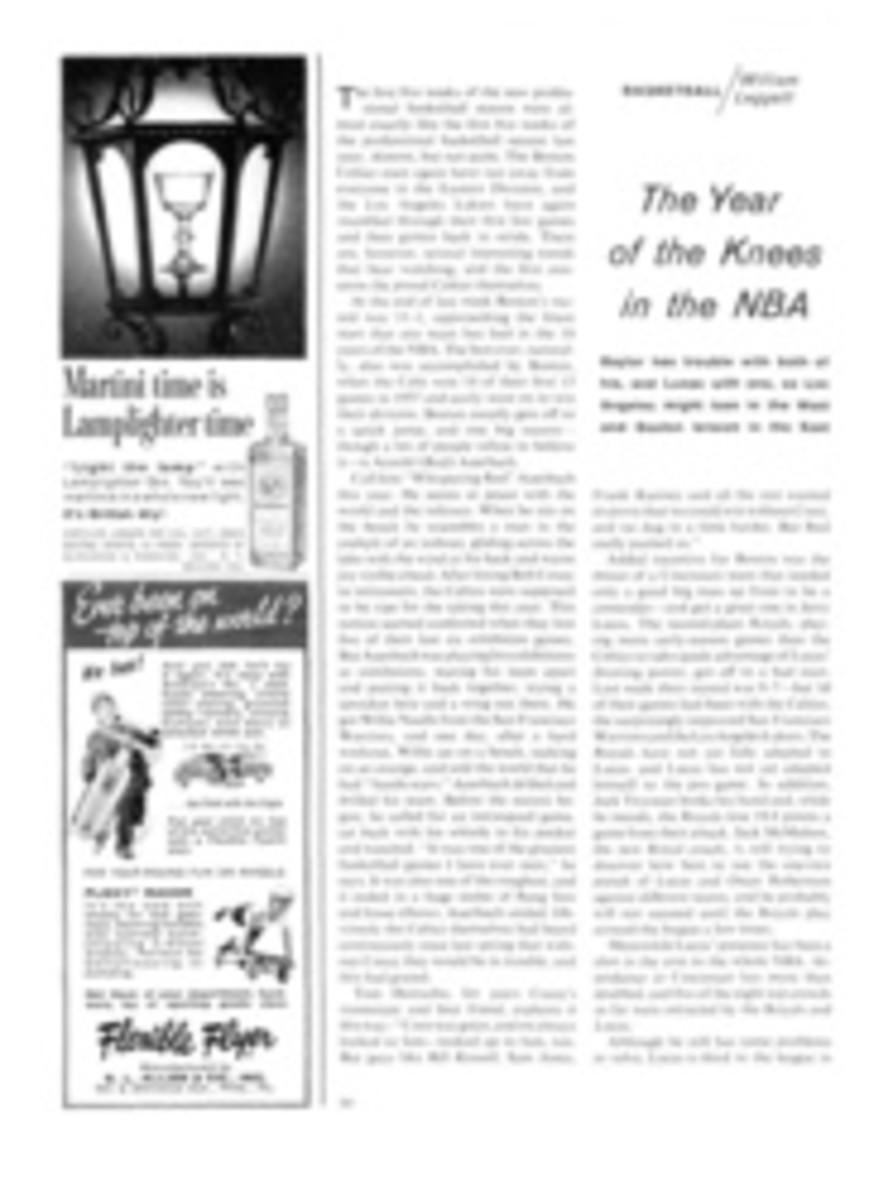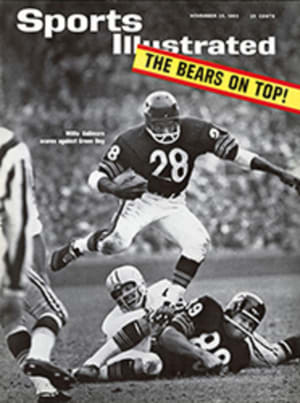
A GUY NAMED SMITH IS STRIKING IT RICH
Night after night, the line leading up to the box office at Long Island's Garden City Bowl snaked all the way out to the street as customers elbowed their way in to see some of the most prosperous stars in the professional sports world compete for one of its richest purses. The event? The $60,000 Professional Bowlers Association National Championships. The stars?
Well, there were Johnny King and Billy Golembiewski and Andy Marzich and Bill Hardwick. And then there was Harry Smith.
Harry Smith?
Yes, Harry Smith. And wipe that expression off your face, you baseball, golt and football fans, because Bowler Harry Smith stands to bank as much money this year as Sandy Koufax and Y. A. Tittle combined. Before last week's action in Garden City, he was No. 1 in prize money on the PBA tour, with winnings of $30,557. In non-PBA tournaments he had earned another $10,000. Don January, the pro golfer and a friend, recently asked Harry how he had done on the bowling tour. He was flabbergasted to learn the amount. "Good lord!" exclaimed January, "I've only won $33,000 on the golf tour!" In addition to his tournament winnings, Harry Smith gets a $20,000-a-year salary as the local pro at Johnny Unitas' Colt Lanes in Baltimore and draws a fee from Brunswick. All in all, what with prizes, salaries, endorsements and TV money, he does so well that he is able to support a wife and four children in style, tool around the circuit in a maroon Lincoln Continental and indulge a taste for epicurean delicacies. Harry, in short, is the personification of the prosperity that has suddenly overtaken the world of professional bowling.
Six or seven years ago pro bowling was little more than a fuzzy picture on Channel 5. Now it is a million-a-year-plus business.
The credit belongs to the PBA and its energetic founder, Eddie Elias, a lawyer and onetime sports announcer from Akron, Ohio (SI, March 5, 1962). When the PBA held its first "tour" four years ago, it had only 33 members, staged three tournaments and could afford only $44,000 in prize money. This year it will put on 38 tournaments and give away more than $1,050,000 in prize money. Of its 942 members, 65 are touring pros who compete in at least half of the tournaments, and, according to Dan Mitseff, PBA director of operations, the minimum any one of them makes is $10,000 a year. Moreover, 15 of the bowlers are in the $30,000-a-year bracket, and there are four or five, including Don Carter, the most famous name in bowling, and Harry Smith, who earn upward of $75,000 annually.
Where does the money come from? Take last week's $60,000 National Championships as an example. The first chunk, $20,000, was put up by the Nassau Bowling Proprietors Association. With revenue derived from sales and advertising in the printed program plus an average of 1,500 admission fees a day for five days at $1 to $3 a ticket, the proprietors figured to at least equal their stake. But even if they did not, the tournament was well worth it as a "stimulant" to local business, says Buddy Russell, owner of Garden City Bowl.
Besides the $20,000 put up by the proprietors, there was a kitty of $24,000 contributed by the bowlers themselves in $125 entry fees, and amateur bowlers who took part in a pro-am tournament came up with $10,000 more. Finally, there was another $6,000 contributed by the PBA from money it has made from television. The American Broadcasting Company pays the PBA $150,000 a year for the TV rights to 13 tournaments and, in addition, the PBA picks up money here and there by packaging such feature programs as Jackpot Bowling, Championship Bowling and Make That Spare. All of these shows have channeled extra money, not only to the association, but into the pockets of such individual members as Therm Gibson of Detroit, who won $75,000 in one night's work on Jackpot Bowling by making six straight strikes.
"We're quite proud of the way we've progressed," crows Eddie Elias. "We fulfilled our five-year plan a little ahead of schedule, and in the next five years we're going to take a number of the boys who have not been able to do well on the tour and train them as resident pros for the country's 7,000 bowling establishments. Within the year we expect to send out 15."
To keep up the spirit of the PBA, membership requirements are strict. The PBA requires that an applicant, who has to be 18 or older, must submit three character references, get an endorsement from one of the 27 members of the national executive board, furnish proof of a yearly scoring average of at least 190 (an average of 190 is equivalent to breaking 80 in golf; bowling 210 is like shooting a 70) and pass a final screening by the executive board. If accepted, the applicant receives a membership card and a yellow PBA shirt (which he is required to wear in tournament finals under penalty of a fine). Each member must compete in at least two tournaments a year, and a bowler who becomes a touring pro by competing in half or more of the tournaments is allowed the privilege of entering any tournament on the tour.
By and large, the members of the PBA are the kindliest and most well-mannered of any athletes appearing before the public. Only three have been called down for bad sportsmanship since the PBA began. The touring pros often go out of their way to help one another. In last week's Nationals, for example, Harry Smith was backing a friend who had been down on his luck on the tour. "What the heck," he says, "I got my start that way."
Now 33, Smith was born on a farm near Cleveland, one of four children. From the beginning he had to scrap. At 8 he was a pool hustler. When the owner of the local pool hall and bowling alley refused to let him shoot unless he set pins, he learned how to bowl and became a hustler in that sport as well. "When I was in high school I made $50, $60 a week shooting pool," he says. "I didn't get much sleep. Then I used to travel 50 miles to get a match game in bowling. The stakes would be $5, $10, $20. I always looked like I was easy to take. I was young, all skin and bones, and unorthodox. Because I was a kid, I had to hold the ball way up high—it weighed 16 pounds—and it would throw me. The weight made me weave and hop. But I always had my aim straight on, and I got the job done. You don't have hustling now. You wouldn't think of making a side bet now. In my first year, when I was 12, I had a 288 game. Then Eddie Koepp, one of the greatest bowlers of all time, took me under his wing and to all the tournaments. When I was in the ninth grade I won $500 in a tournament in Cleveland, and that was like a million dollars."
In 1957 Smith joined the Falstaff Beer team in St. Louis. In his first year he received a salary of $5,000 and won an additional $6,000 in prize money. But that, of course, was before the palmy days of the PBA.
Now, with the PBA riding high, Smith's major concern is not where his next stake is coming from but how the stock market is doing. (He got "killed" in the May slump a year ago.) Harry finished well out of the big money at the Nationals last week, winding up 28 places behind the winner, Bill Hardwick, to add a meager $290 to his winnings. But in the middle of the tournament he took time off to nip over to Paramus, N.J. and appear on Make That Spare.
Smith did make that spare and banked another $2,000 as a result, meanwhile putting on the finest exhibition ever seen on the program. This week Harry is due to appear again with a chance to get $10,000 if he makes the jackpot spare. Win or lose, he figures he is ahead of the game. He says, "People used to say, 'What do you do?' And I'd say I was a pro bowler, and they'd say, 'Cripes,' like they were sorry for you. Now when you tell 'em, they look up to you. We've come a long way."
THREE PHOTOS
WALTER IOOSS JR.
Bowler Harry Smith, whose body English earns him more than $75,000 a year, puts it to work to insure a clean strike at the Professional Bowlers Association championships on Long Island.
PHOTO
Tangible evidence of pro bowling's prosperity gleams in Harry Smith's Lincoln Continental.

